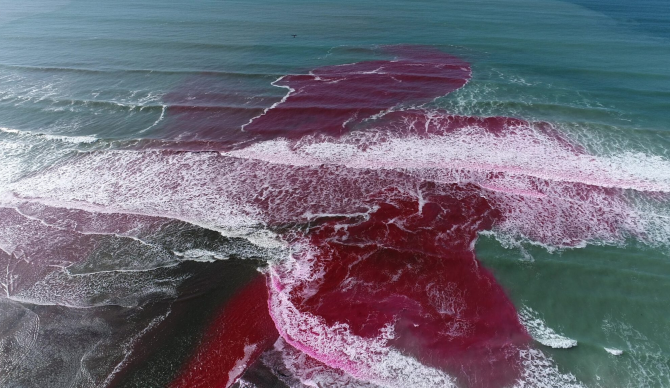
Photo: Scripps Institute of Oceanography
Patches of pink water were seen flowing out into the Pacific near Torrey Pines last week. But news reports quickly assured the public the colored water wasn’t polluted runoff, it was part of a three-day experiment conducted by researchers at UC San Diego’s Scripps Institute of Oceanography and researchers from the University of Washington.
The project, titled Plumes in Nearshore Conditions (PiNC) has been studying how small outflows of freshwater interact with ocean water when it reaches the surf zone. Each dye release consists of 15 gallons of pink water that can be seen in the ocean with the naked eye for several hours and tracked with special equipment for up to 24 hours. From there, researchers monitor how the freshwater moves once they release it from freshwater reserves like Friday morning’s low tide release near the estuary mouth at the Los Peñasquitos Lagoon. They monitor the pink blobs using drones, surveying the area with jet skis, and poles in the sand of the river mouth with special sensors attached. Over the course of the research project, this will teach them how waves distribute and move sediment around smaller waterways.
Similar dye studies have been conducted in Southern California in the past and Scripps researchers pointed out while those experiments monitored the momentum of the water outflow, they didn’t consider how it was impacted by the buoyancy of the outlet.
“Our first hypothesis (H1) is that the fresh river water will either be trapped in the surf zone or may escape past the surf zone as a freshwater plume, or a combination of the two, and this behavior will be determined by the balance of wave and river forcings,” researchers wrote. “Our second hypothesis (H2) is that we will be able to parameterize this system, and the likelihood of trapping versus escapes, in the context of other estuarine systems such as the Quinault and Maipo Rivers. If the freshwater is trapped in the surf zone, our third hypothesis (H3) is that the fresh water will primarily escape the surf zone through rip current activity. Last, we hypothesize (H4) that the freshwater will be mixed in the surf zone by waves, and that we will be able to model this using existing turbulence closure models.”

